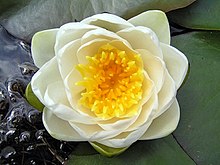
Back Waterplant Afrikaans نبات مائي Arabic Planta acuática AST Su bitkiləri Azerbaijani Гидрофиттар Bashkir Водни растения Bulgarian জলজ উদ্ভিদ Bengali/Bangla Vodena biljka BS Planta aquàtica Catalan Hydrofyty Czech


Aquatic plants are plants that have adapted to living in aquatic environments (saltwater or freshwater). They are also referred to as hydrophytes or macrophytes to distinguish them from algae and other microphytes. A macrophyte is a plant that grows in or near water and is either emergent, submergent, or floating. In lakes and rivers, macrophytes provide cover for fish, substrate for aquatic invertebrates, produce oxygen, and act as food for some fish and wildlife.[1]
Macrophytes are primary producers and are the basis of the food web for many organisms.[2] They have a significant effect on soil chemistry and light levels [3] as they slow down the flow of water and capture pollutants and trap sediments. Excess sediment will settle into the benthos aided by the reduction of flow rates caused by the presence of plant stems, leaves and roots. Some plants have the capability of absorbing pollutants into their tissue.[4][5] Seaweeds are multicellular marine algae and, although their ecological impact is similar to other larger water plants, they are not typically referred to as macrophytes.[5]
Aquatic plants require special adaptations for living submerged in water, or at the water's surface. The most common adaptation is the presence of lightweight internal packing cells, aerenchyma, but floating leaves and finely dissected leaves are also common.[6][7][8] Aquatic plants can only grow in water or in soil that is frequently saturated with water. They are therefore a common component of wetlands.[9] One of the largest aquatic plants in the world is the Amazon water lily; one of the smallest is the minute duckweed. Many small aquatic animals use plants such as duckweed for a home, or for protection from predators. Some other familiar examples of aquatic plants include floating heart, water lily, lotus, and water hyacinth.
Historically, aquatic plants have been less studied than terrestrial plants.[10]
- ^ "Macrophytes as Indicators of freshwater marshes in Florida" (PDF). Archived (PDF) from the original on 2014-04-07. Retrieved 2014-04-05.
- ^ Chambers, Patricia A. (September 1987). "Light and Nutrients in the Control of Aquatic Plant Community Structure. II. In Situ Observations". The Journal of Ecology. 75 (3): 621–628. Bibcode:1987JEcol..75..621C. doi:10.2307/2260194. JSTOR 2260194.
- ^ "Do macrophytes play a role in constructed treatment wetlands?". Water Science and Technology. 35 (5). 1997. doi:10.1016/s0273-1223(97)00047-4. ISSN 0273-1223.
- ^ Cowardin, Lewis M.; Carter, Virginia; Golet, Francis C.; Laroe, Edward T. (2005-07-15), "Classification of Wetlands and Deepwater Habitats of the United States", in Lehr, Jay H.; Keeley, Jack (eds.), Water Encyclopedia, John Wiley & Sons, Inc., pp. sw2162, doi:10.1002/047147844x.sw2162, ISBN 9780471478447, archived from the original on 2019-12-21, retrieved 2019-11-16
- ^ a b Krause-Jensen, Dorte; Sand-Jensen, Kaj (May 1998). "Light attenuation and photosynthesis of aquatic plant communities". Limnology and Oceanography. 43 (3): 396–407. Bibcode:1998LimOc..43..396K. doi:10.4319/lo.1998.43.3.0396. ISSN 0024-3590. S2CID 85700950.
- ^ Sculthorpe, C. D. 1967. The Biology of Aquatic Vascular Plants. Reprinted 1985 Edward Arnold, by London.
- ^ Hutchinson, G. E. 1975. A Treatise on Limnology, Vol. 3, Limnological Botany. New York: John Wiley.
- ^ Cook, C.D.K. (ed). 1974. Water Plants of the World. Dr W Junk Publishers, The Hague. ISBN 90-6193-024-3.
- ^ Keddy, P.A. 2010. Wetland Ecology: Principles and Conservation (2nd edition). Cambridge University Press, Cambridge, UK. 497 p.
- ^ Maréchal, Eric (2019). "Marine and Freshwater Plants: Challenges and Expectations". Frontiers in Plant Science. 10: 1545. doi:10.3389/fpls.2019.01545. ISSN 1664-462X. PMC 6883403. PMID 31824548.
© MMXXIII Rich X Search. We shall prevail. All rights reserved. Rich X Search